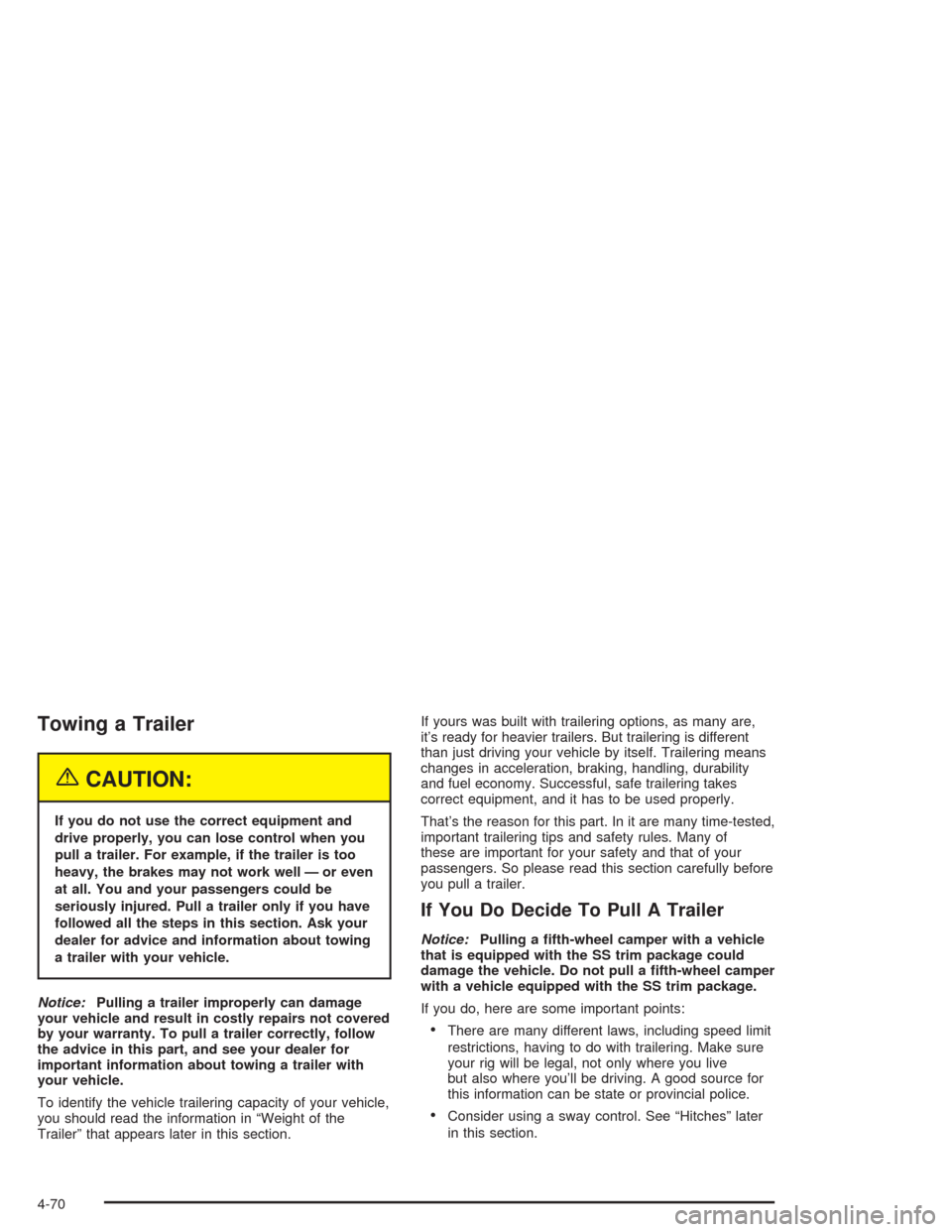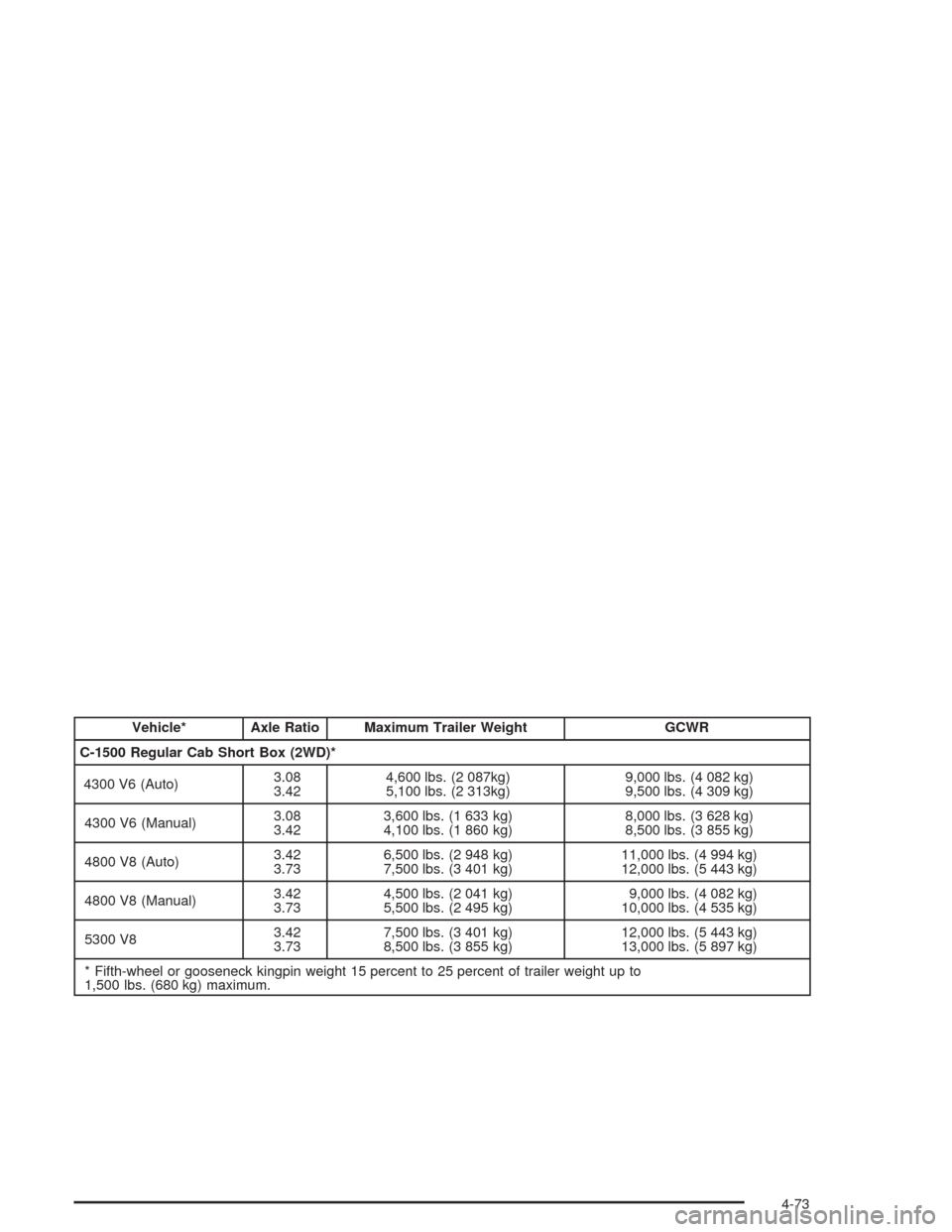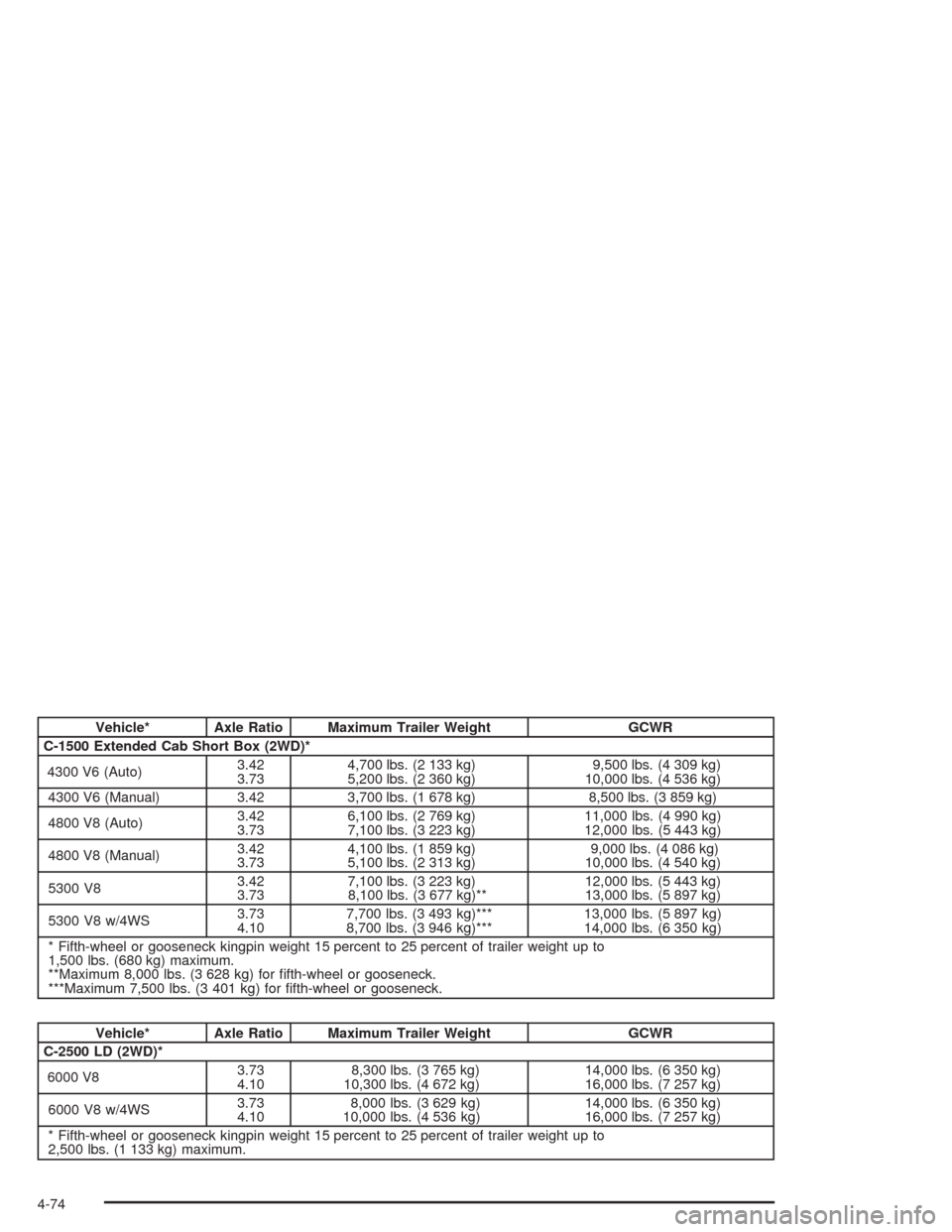2004 CHEVROLET SILVERADO wheel
[x] Cancel search: wheelPage 350 of 584

4. Firmly set the parking brake.
5. Securely attach the vehicle being towed to the
tow dolly.
{CAUTION:
Shifting a four-wheel-drive vehicle’s transfer
case into NEUTRAL can cause your vehicle to
roll even if the transmission is in Park (P) for
an automatic transmission, or if your vehicle is
in gear, for a manual transmission. You or
others could be injured. Make sure the parking
brake is �rmly set before you shift the transfer
case to NEUTRAL.
6. Shift the transfer case to NEUTRAL. See
Four-Wheel Drive on page 2-36for the proper
procedure to select the neutral position for
your vehicle.
7. Release the parking brake only after the
vehicle being towed is �rmly attached to the
towing vehicle.
8. Turn the ignition off and lock the steering column.
Loading Your Vehicle
It is very important to know how much weight your
vehicle can carry. This weight is called the vehicle
capacity weight and includes the weight of all occupants,
cargo and all nonfactory-installed options. Two labels
on your vehicle show how much weight it may properly
carry, the Tire and Loading Information label and the
Certi�cation/Tire label.
{CAUTION:
Do not load your vehicle any heavier than the
GVWR, or either the maximum front or rear
GAWR. If you do, parts on your vehicle can
break, and it can change the way your vehicle
handles. These could cause you to lose
control and crash. Also, overloading can
shorten the life of your vehicle.
4-56
Page 356 of 584

Payload
Payload capacity is the maximum load capacity that
your vehicle can carry. Be sure to include the weight of
the occupants as part of your load. If you added any
accessories or equipment after your vehicle left
the factory, remember to subtract the weight of these
things from the payload. Your dealer can help you
with this.
Remember not to exceed the Gross Axle Weight
Rating (GAWR) of the front or rear axle.
Two-Tiered Loading
By positioning four 2” x 6” wooden planks across the
width of the pickup box, you can create an upper
load platform. The planks must be inserted in the pickup
box depressions. The length of the planks must allow
for at least a 3/4 inch (2 cm) bearing surface on
each end of the plank.When using this upper load platform, be sure the load is
securely tied down to prevent it from shifting. The
load’s center of gravity should be positioned in a zone
over the rear axle. The zone is located in the area
between the front of each wheel well and the rear of
each wheel well. The center of gravity height must not
extend above the top of the pickup box �areboard.
Any load that extends beyond the vehicle’s taillamp
area must be properly marked according to local laws
and regulations.
Remember not to exceed the Gross Axle Weight
Rating (GAWR) of the front or rear axle.Add-On Equipment
When you carry removable items, you may need to put
a limit on how many people you carry inside your
vehicle. Be sure to weigh your vehicle before you buy
and install the new equipment.
Notice:Overloading your vehicle may cause
damage. Repairs would not be covered by your
warranty. Do not overload your vehicle.
4-62
Page 359 of 584

Q:What is front axle reserve capacity, and how do
I calculate it?
A:Front axle reserve capacity is the difference
between your front GAWR and the front axle weight
of your truck with full fuel and passengers.
Basically, it is the amount of weight you can add to
your front axle before reaching your front GAWR.
The front axle reserve capacity for your vehicle can be
found in the lower right corner of the Certi�cation/Tire
label, as shown.In order to calculate the amount of weight any front
accessory, such as a snow plow, is adding to the front
axle, use the following formula:
(W x (A + W.B.)) /W.B.= Weight the accessory is adding
to the front axle.
Where:
W = Weight of added accessory
A = Distance that the accessory is in front of the
front axle
W.B. = Vehicle Wheelbase United States
Canada
4-65
Page 360 of 584

For example, adding a 700 lb. (318 kg) snow plow
actually adds more than 700 lb. (318 kg) to the front
axle. Using the formula, if the snow plow is 4 ft. (122 cm)
in front of the front axle and the wheel base is 10 ft.
(305 cm), then:
W = 700 lb. (318 kg)
A = 4 ft. (122 cm)
W.B. = 10 ft. (305 cm)
(W x (A + W.B.))/W.B. = (700 x (4 + 10))/10 =
980 lb. (445 kg)
So, if your truck’s front axle reserve capacity is more
than 980 lb. (445 kg), you could add the snow plow
without exceeding the front GAWR.
Q:What if I want to add heavier equipment to
my vehicle?
A:You can add heavier equipment on the front of the
vehicle if you compensate for it by carrying fewer
passengers, less cargo, or by positioning cargo
towards the rear. This has the effect of reducing the
load on the front. However, the front GAWR, rear
GAWR and the GVWR must never be exceeded.
{CAUTION:
On some vehicles equipped with certain front
mounted equipment, such as a snow plow, it
may be possible to load the front axle to the
front GAWR but not have enough weight on
the rear axle to have proper braking
performance. If your brakes can not work
properly, you could have a crash. To help your
brakes work properly when a snow plow is
installed, always follow the snow plow
manufacturer or installer’s recommendation for
rear ballast to ensure a proper front and rear
weight distribution ratio, even though the
actual front weight may be less than the front
GAWR, and the total vehicle weight is less
than the GVWR. Maintaining a proper front and
rear weight distribution ratio is necessary to
provide proper braking performance.
4-66
Page 363 of 584

Your dealer can help you make a good vehicle-camper
match and help you determine the CWR.
After you’ve loaded your vehicle and camper, drive to a
weigh station and weigh the front and rear wheels
separately. This will tell you the loads on the axles. The
loads on the front and rear axles shouldn’t be more
than either of the GAWRs. The total of the axle loads
should not be more than the GVWR.
Open the driver’s door and look at the Certi�cation/Tire
label to �nd out your GAWR and GVWR.
If you’ve gone over the weight ratings, move or take out
some things until all the weight falls below the ratings.
Of course, you should always tie down any loose
items when you load your vehicle or camper.
When you install and load your slide-in camper, check
the manufacturer’s instructions.
If you want more information on curb weights, cargo
weights, Cargo Weight Rating and the correct center of
gravity zone for your vehicle, your dealer can help
you. Just ask for a copy of″Consumer Information,
Truck-Camper Loading.″Trailer Recommendations
You must subtract your hitch loads from the CWR for
your vehicle. Weigh your vehicle with the trailer
attached, so that you won’t go over the GVWR or
GAWR. If you are using a weight-distributing hitch,
weigh the vehicle without the spring bars in place.
You’ll get the best performance if you spread out the
weight of your load the right way, and if you choose the
correct hitch and trailer brakes.
For more information, seeTowing a Trailer on
page 4-70.
Pickup Conversion to Chassis Cab
General Motors is aware that some vehicle owners may
consider having the pickup box removed and a
commercial or recreational body installed. Before you do
so, �rst contact GM Customer Assistance for information
on such conversions speci�c to this vehicle. Owners
should be aware that, as manufactured, there are
differences between a chassis cab and a pickup with
the box removed which may affect vehicle safety.
The components necessary to adapt a pickup to permit
its safe use with a specialized body should be
installed by a body builder in accordance with the
information available from GM Customer Assistance.
SeeCustomer Assistance Offices on page 7-4.
4-69
Page 364 of 584

Towing a Trailer
{CAUTION:
If you do not use the correct equipment and
drive properly, you can lose control when you
pull a trailer. For example, if the trailer is too
heavy, the brakes may not work well — or even
at all. You and your passengers could be
seriously injured. Pull a trailer only if you have
followed all the steps in this section. Ask your
dealer for advice and information about towing
a trailer with your vehicle.
Notice:Pulling a trailer improperly can damage
your vehicle and result in costly repairs not covered
by your warranty. To pull a trailer correctly, follow
the advice in this part, and see your dealer for
important information about towing a trailer with
your vehicle.
To identify the vehicle trailering capacity of your vehicle,
you should read the information in “Weight of the
Trailer” that appears later in this section.If yours was built with trailering options, as many are,
it’s ready for heavier trailers. But trailering is different
than just driving your vehicle by itself. Trailering means
changes in acceleration, braking, handling, durability
and fuel economy. Successful, safe trailering takes
correct equipment, and it has to be used properly.
That’s the reason for this part. In it are many time-tested,
important trailering tips and safety rules. Many of
these are important for your safety and that of your
passengers. So please read this section carefully before
you pull a trailer.
If You Do Decide To Pull A Trailer
Notice:Pulling a �fth-wheel camper with a vehicle
that is equipped with the SS trim package could
damage the vehicle. Do not pull a �fth-wheel camper
with a vehicle equipped with the SS trim package.
If you do, here are some important points:
There are many different laws, including speed limit
restrictions, having to do with trailering. Make sure
your rig will be legal, not only where you live
but also where you’ll be driving. A good source for
this information can be state or provincial police.
Consider using a sway control. See “Hitches” later
in this section.
4-70
Page 367 of 584

Vehicle* Axle Ratio Maximum Trailer Weight GCWR
C-1500 Regular Cab Short Box (2WD)*
4300 V6 (Auto)3.08
3.424,600 lbs. (2 087kg)
5,100 lbs. (2 313kg)9,000 lbs. (4 082 kg)
9,500 lbs. (4 309 kg)
4300 V6 (Manual)3.08
3.423,600 lbs. (1 633 kg)
4,100 lbs. (1 860 kg)8,000 lbs. (3 628 kg)
8,500 lbs. (3 855 kg)
4800 V8 (Auto)3.42
3.736,500 lbs. (2 948 kg)
7,500 lbs. (3 401 kg)11,000 lbs. (4 994 kg)
12,000 lbs. (5 443 kg)
4800 V8 (Manual)3.42
3.734,500 lbs. (2 041 kg)
5,500 lbs. (2 495 kg)9,000 lbs. (4 082 kg)
10,000 lbs. (4 535 kg)
5300 V83.42
3.737,500 lbs. (3 401 kg)
8,500 lbs. (3 855 kg)12,000 lbs. (5 443 kg)
13,000 lbs. (5 897 kg)
* Fifth-wheel or gooseneck kingpin weight 15 percent to 25 percent of trailer weight up to
1,500 lbs. (680 kg) maximum.
4-73
Page 368 of 584

Vehicle* Axle Ratio Maximum Trailer Weight GCWR
C-1500 Extended Cab Short Box (2WD)*
4300 V6 (Auto)3.42
3.734,700 lbs. (2 133 kg)
5,200 lbs. (2 360 kg)9,500 lbs. (4 309 kg)
10,000 lbs. (4 536 kg)
4300 V6 (Manual) 3.42 3,700 lbs. (1 678 kg) 8,500 lbs. (3 859 kg)
4800 V8 (Auto)3.42
3.736,100 lbs. (2 769 kg)
7,100 lbs. (3 223 kg)11,000 lbs. (4 990 kg)
12,000 lbs. (5 443 kg)
4800 V8 (Manual)3.42
3.734,100 lbs. (1 859 kg)
5,100 lbs. (2 313 kg)9,000 lbs. (4 086 kg)
10,000 lbs. (4 540 kg)
5300 V83.42
3.737,100 lbs. (3 223 kg)
8,100 lbs. (3 677 kg)**12,000 lbs. (5 443 kg)
13,000 lbs. (5 897 kg)
5300 V8 w/4WS3.73
4.107,700 lbs. (3 493 kg)***
8,700 lbs. (3 946 kg)***13,000 lbs. (5 897 kg)
14,000 lbs. (6 350 kg)
* Fifth-wheel or gooseneck kingpin weight 15 percent to 25 percent of trailer weight up to
1,500 lbs. (680 kg) maximum.
**Maximum 8,000 lbs. (3 628 kg) for �fth-wheel or gooseneck.
***Maximum 7,500 lbs. (3 401 kg) for �fth-wheel or gooseneck.
Vehicle* Axle Ratio Maximum Trailer Weight GCWR
C-2500 LD (2WD)*
6000 V83.73
4.108,300 lbs. (3 765 kg)
10,300 lbs. (4 672 kg)14,000 lbs. (6 350 kg)
16,000 lbs. (7 257 kg)
6000 V8 w/4WS3.73
4.108,000 lbs. (3 629 kg)
10,000 lbs. (4 536 kg)14,000 lbs. (6 350 kg)
16,000 lbs. (7 257 kg)
* Fifth-wheel or gooseneck kingpin weight 15 percent to 25 percent of trailer weight up to
2,500 lbs. (1 133 kg) maximum.
4-74